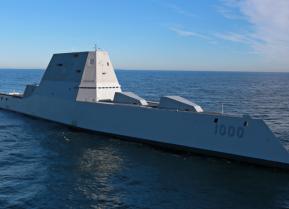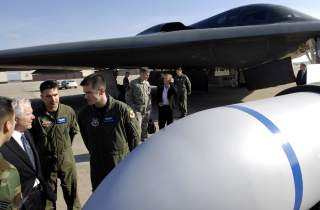Ultimate Weapon: Why America's Enemies Fear the GBU-43/B Massive Ordnance Air Blast
While many media sources tout the GBU-43/B as the largest conventional bomb ever built, it’s not really the case.
The casing is what allows the massive GBU-57 weapon to penetrate some of the hardest bunkers potential adversaries have built. The Air Force is currently developing a Next Generation Penetrator Munition to replace the MOP as enemy fortifications become ever more hardened and deeply buried.
The United States Air Force has dropped one of the largest non-nuclear bombs ever built on an ISIS terrorist tunnel network in Afghanistan. The weapon—called the GBU-43/B Massive Ordnance Air Blast— was dropped from a Lockheed Martin MC-130 belonging to U.S. Air Force Special Operations command.
(This first appeared last year.)
The Pentagon has not released any specific details about the air strike, but the use of the GBU-43 suggests a very significant network of tunnels. The GBU-43—is a 22,600lbs weapon with 18,700lbs of H-6 explosive filler—is an inertially guided weapon that relies on GPS course corrections just like the JDAM series weapons. When the GBU-43/B was originally developed, it was the most powerful non-nuclear bomb ever built—but has been surpassed by other weapons.
“The GBU-43/B Massive Ordnance Air Blast (MOAB pronounced (commonly known as the Mother of All Bombs) is a large-yield conventional (non-nuclear) bomb, developed for the United States,” the U.S. Air Force Armament Museum states on its site. “At the time of development, it was touted as the most powerful non-nuclear weapon ever designed.”
The GBU-43/B is not a penetrating weapon and is generally intended for use against softer targets in confined spaces such as caves or canyons. In other words—it’s perfect for use against concentrations of insurgent fighters in Afghanistan.
While many media sources tout the GBU-43/B as the largest conventional bomb ever built, it’s not really the case. The U.S. Air Force also fields the GBU-57A/B Massive Ordnance Penetrator (MOP), which is a massive precision-guided 30,000lb bunker-busting weapon that is usually dropped from a Northrop Grumman B-2 Spirit stealth bomber. However, the GBU-57A/B only contains 5,300lbs of explosive filler—the vast bulk of the weapon comes from the hardened casing.
The casing is what allows the massive GBU-57 weapon to penetrate some of the hardest bunkers potential adversaries have built. The Air Force is currently developing a Next Generation Penetrator Munition to replace the MOP as enemy fortifications become ever more hardened and deeply buried.
Recommended: What Will the Sixth-Generation Jet Fighter Look Like?
Recommended: Imagine a U.S. Air Force That Never Built the B-52 Bomber
Recommended: Russia's Next Big Military Sale - To Mexico?
Recommended: Would China Really Invade Taiwan?
Meanwhile, not to be out done, Russia’s ATBIP—though physically smaller than the GBU-43/B—has a much larger explosive yield. Based around thermobaric explosives, the ATBIP–sometimes called the ‘Father of All Bombs’–has the destructive power equivalent to roughly 88,000lbs of TNT, which is roughly four times that of the MOAB. The Russian weapons also has roughly double the blast radius.
Of course, none of these conventional weapons comes close to the power of a nuclear weapon. Nuclear weapons—for their relatively diminutive physical size—offer unparalleled destructive power. America’s premier tactical nuclear weapon—the B-61 thermonuclear bomb—for example, weighs roughly 700lbs but could—depending on the variant—have a yield of 340 kilotons. Indeed, the Little Boy—the primitive atom bomb dropped on Hiroshima—physically weighed 9,700lbs but offered a yield of 15 kilotons or many orders of magnitude greater than even that largest conventional bomb.
Dave Majumdar is the defense editor for The National Interest. You can follow him on Twitter: @davemajumdar.


